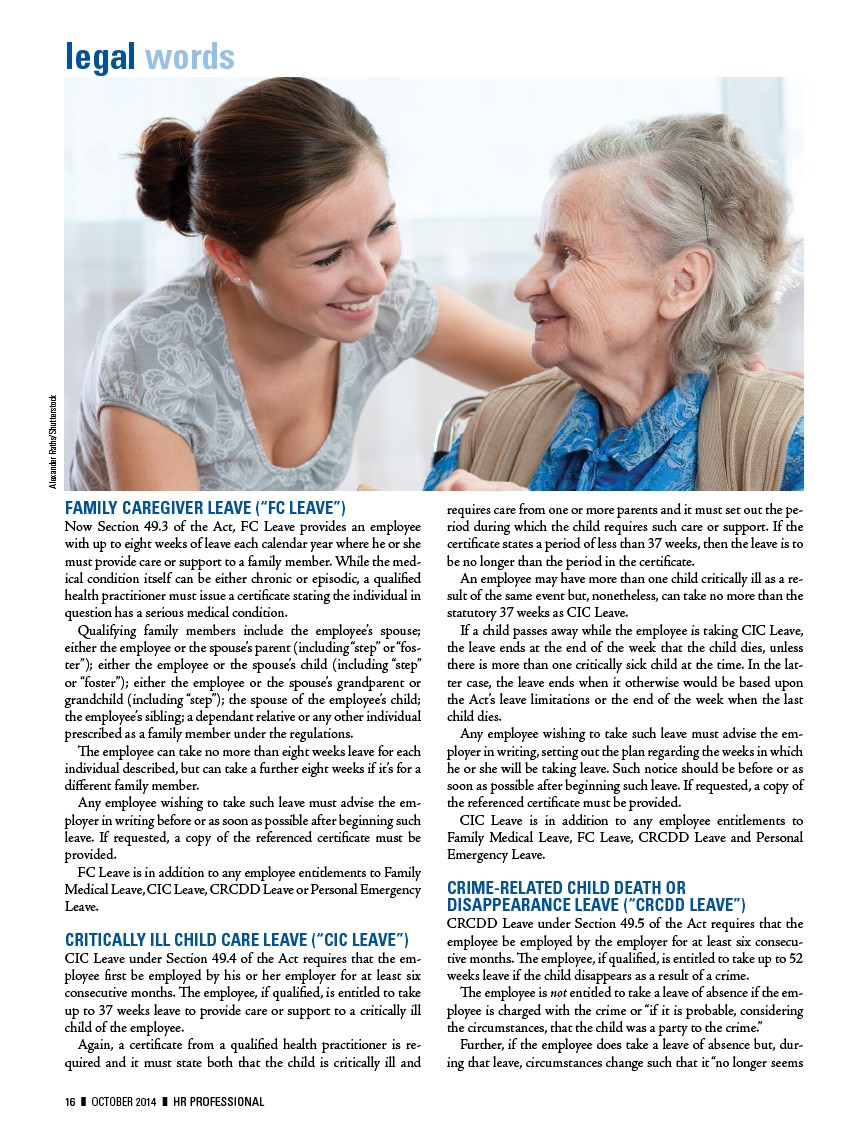
FAMILY CAREGIVER LEAVE (“FC LEAVE”)
Now Section 49.3 of the Act, FC Leave provides an employee
with up to eight weeks of leave each calendar year where he or she
must provide care or support to a family member. While the med-ical
condition itself can be either chronic or episodic, a qualified
health practitioner must issue a certificate stating the individual in
question has a serious medical condition.
Qualifying family members include the employee’s spouse;
either the employee or the spouse’s parent (including “step” or “fos-ter”);
either the employee or the spouse’s child (including “step”
or “foster”); either the employee or the spouse’s grandparent or
grandchild (including “step”); the spouse of the employee’s child;
the employee’s sibling; a dependant relative or any other individual
prescribed as a family member under the regulations.
The employee can take no more than eight weeks leave for each
individual described, but can take a further eight weeks if it’s for a
different family member.
Any employee wishing to take such leave must advise the em-ployer
in writing before or as soon as possible after beginning such
leave. If requested, a copy of the referenced certificate must be
provided.
FC Leave is in addition to any employee entitlements to Family
Medical Leave, CIC Leave, CRCDD Leave or Personal Emergency
Leave.
CRITICALLY ILL CHILD CARE LEAVE (“CIC LEAVE”)
CIC Leave under Section 49.4 of the Act requires that the em-ployee
first be employed by his or her employer for at least six
consecutive months. The employee, if qualified, is entitled to take
up to 37 weeks leave to provide care or support to a critically ill
child of the employee.
Again, a certificate from a qualified health practitioner is re-quired
and it must state both that the child is critically ill and
requires care from one or more parents and it must set out the pe-riod
during which the child requires such care or support. If the
certificate states a period of less than 37 weeks, then the leave is to
be no longer than the period in the certificate.
An employee may have more than one child critically ill as a re-sult
of the same event but, nonetheless, can take no more than the
statutory 37 weeks as CIC Leave.
If a child passes away while the employee is taking CIC Leave,
the leave ends at the end of the week that the child dies, unless
there is more than one critically sick child at the time. In the lat-ter
case, the leave ends when it otherwise would be based upon
the Act’s leave limitations or the end of the week when the last
child dies.
Any employee wishing to take such leave must advise the em-ployer
in writing, setting out the plan regarding the weeks in which
he or she will be taking leave. Such notice should be before or as
soon as possible after beginning such leave. If requested, a copy of
the referenced certificate must be provided.
CIC Leave is in addition to any employee entitlements to
Family Medical Leave, FC Leave, CRCDD Leave and Personal
Emergency Leave.
CRIME-RELATED CHILD DEATH OR
DISAPPEARANCE LEAVE (“CRCDD LEAVE”)
CRCDD Leave under Section 49.5 of the Act requires that the
employee be employed by the employer for at least six consecu-tive
months. The employee, if qualified, is entitled to take up to 52
weeks leave if the child disappears as a result of a crime.
The employee is not entitled to take a leave of absence if the em-ployee
is charged with the crime or “if it is probable, considering
the circumstances, that the child was a party to the crime.”
Further, if the employee does take a leave of absence but, dur-ing
that leave, circumstances change such that it “no longer seems
legal words
Alexander Raths/Shutterstock
16 ❚ OCTOBER 2014 ❚ HR PROFESSIONAL